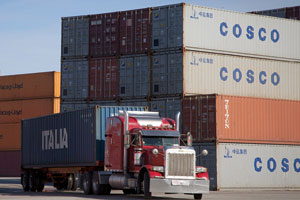Intermodal Drops 4.6% as Trucking Gains Loads

This story appears in the Nov. 14 print edition of Transport Topics.
Intermodal volumes declined in the third quarter because truck prices are lower than a year ago and that has diverted business away from railroads, the Intermodal Association of North America reported.
The quarterly number of trailers and containers loaded onto railcars dropped 4.6% to 4.3 million units, year-over-year. The sole bright spot was domestic container traffic, which increased 3.3% to 1.9 million units. International containers fell 6.7% to 2.2 million during the quarter.
“It’s been a tough year. There’s never been two consecutive negative quarters except in an economic recession, but we are in a freight recession right now,” Pat Casey, vice president of fleet management at TTX Co., said in a Nov. 8 webinar.
Overcapacity in trucking, low diesel prices and the usefulness of transloading persuaded shippers to book truck-only shipping to reduce their supply chain costs, he said. Intermodal marketing companies reported an 11.6% decline in rail loadings in the quarter, but a 14.6% jump in highway loadings, year-over-year.
“What’s been surprising recently is that we’re hearing anecdotes of freight being moved from the West Coast ports to the Midwest by truck because there is so much capacity out there and so many empty trucks with very cheap prices,” Casey added. “Five years ago, I would’ve said that nobody trucks a container from Los Angeles to Chicago, but they’re doing it today.”
The rail share of inland transportation from ports in Los Angeles and Long Beach, California, was down 2.6% from January through September compared with the previous year, IANA reported.
Curtis Whalen, executive director of American Trucking Associations’ Intermodal Motor Carriers Conference, said using either trucks or intermodal benefits trucking revenues.
“If you use more truck than rail, that’s good, but if it slides back, you’re still doing a truck-to-rail move. Rail may move more freight in one corridor in a given quarter, but truckers are at the end to get the commodity and move it to the final destination. It cushions the ebbs and flows of transporting freight,” he said.
Transloading is another important part of the shipping equation. The process involves transferring goods from international to domestic containers near a port. International containers are 20, 40 or 45 feet long versus 53 feet for domestic equipment. That allows shippers to move fewer containers inland and separate the cargo based on the final destination.
Peter Wolff, director of marketing at TTX, said the market share of transloading is about one-third of all imports landing along the Pacific Coast, up about 3% since 2010.
“The steamship lines don’t mind because it allows them to keep their marine containers on the coast, rather than being routed inland. Trucking and third-party logistics firms like J.B. Hunt, Schneider, Swift or Hub get to handle 53-foot containers, and the railroads seem to like it,” he said.
Wolff suggested more service from Asia to the East Coast through the expanded Panama Canal also could be a factor in the mix of shipping techniques because more of that cargo ends up on trucks.
IANA also said the Hanjin Shipping Co. bankruptcy skewed the results because several vessels were afloat at sea for as long as five weeks. Once the cargo arrived, some owners paid for expedited services to get the goods inland.
Drewry Shipping Consultants wrote last month that container lines could lose up to $5 billion combined in 2016, a sign the industry overall has struggled.
“There’s a global trade slowdown, which is at or below GDP levels, uneven consumer spending and a not fully recovered housing market. The goods aren’t going somewhere else, they’re just not going,” said Anthony Hatch, a rail industry consultant for ABH Consulting.
Intermodal trailer loads dropped 27% year-over-year to 295,933 units in the third quarter, in part because Norfolk Southern Corp. scaled back its Triple Crown trailer network last year.
Intermodal could have a better year in 2017, based on forecasts for the trucking and ocean freight industries. The Drewry report predicted freight rates and cargo volumes will increase and industry operating profits will be $2.5 billion. Spot rates in trucking climbed in the third quarter and capacity could tighten as the driver electronic logging device mandate gets closer, according Keybanc Capital Markets analyst Todd Fowler.
“We expect the truck market to continue to firm and tighten in 2017, helping truck pricing and then ultimately push some freight back into the intermodal lanes. We expect intermodal volumes and pricing to bottom out this year, then start to improve as we move through 2017,” he said.
Hatch said he believes, though, the presidential election added uncertainty for intermodal. He said the outcome could depend on whether the economy can surpass 3% GDP growth in 2017.
“There were signs that the economy would do pretty well and a strong piece of it was going to be business to and from Mexico, such as auto parts. But that could be a problem now depending on the future of Nafta,” Hatch said.

